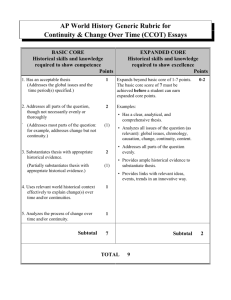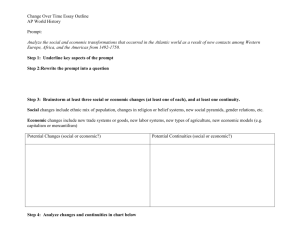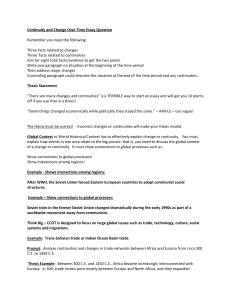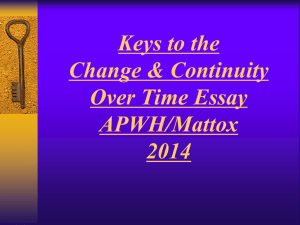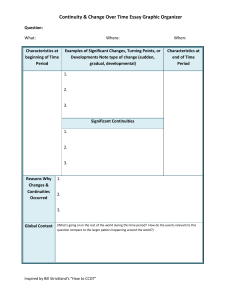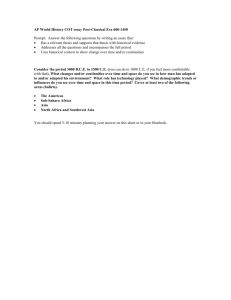AP World History CCOT Essay Guide
advertisement
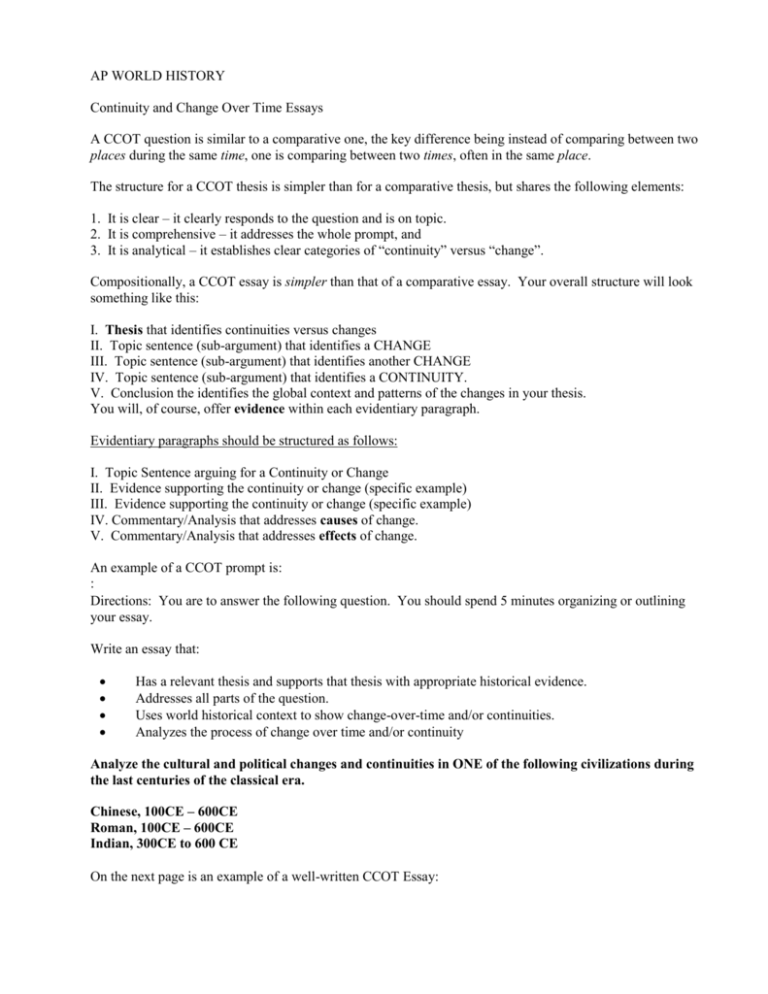
AP WORLD HISTORY Continuity and Change Over Time Essays A CCOT question is similar to a comparative one, the key difference being instead of comparing between two places during the same time, one is comparing between two times, often in the same place. The structure for a CCOT thesis is simpler than for a comparative thesis, but shares the following elements: 1. It is clear – it clearly responds to the question and is on topic. 2. It is comprehensive – it addresses the whole prompt, and 3. It is analytical – it establishes clear categories of “continuity” versus “change”. Compositionally, a CCOT essay is simpler than that of a comparative essay. Your overall structure will look something like this: I. Thesis that identifies continuities versus changes II. Topic sentence (sub-argument) that identifies a CHANGE III. Topic sentence (sub-argument) that identifies another CHANGE IV. Topic sentence (sub-argument) that identifies a CONTINUITY. V. Conclusion the identifies the global context and patterns of the changes in your thesis. You will, of course, offer evidence within each evidentiary paragraph. Evidentiary paragraphs should be structured as follows: I. Topic Sentence arguing for a Continuity or Change II. Evidence supporting the continuity or change (specific example) III. Evidence supporting the continuity or change (specific example) IV. Commentary/Analysis that addresses causes of change. V. Commentary/Analysis that addresses effects of change. An example of a CCOT prompt is: : Directions: You are to answer the following question. You should spend 5 minutes organizing or outlining your essay. Write an essay that: Has a relevant thesis and supports that thesis with appropriate historical evidence. Addresses all parts of the question. Uses world historical context to show change-over-time and/or continuities. Analyzes the process of change over time and/or continuity Analyze the cultural and political changes and continuities in ONE of the following civilizations during the last centuries of the classical era. Chinese, 100CE – 600CE Roman, 100CE – 600CE Indian, 300CE to 600 CE On the next page is an example of a well-written CCOT Essay: From 100 – 600CE China’s culture changed with the spread of Buddhism and development of neo-Confucianism and with the transition from the Han through Tang Rule. Throughout the time period women remained lower status than men and the political influence of Confucianism stayed in place The spread of Buddhism and development of Neo-Confucianism represented cultural changes in China. Buddhist monasteries gained political and economic influence through acting as advisors to rulers and through generous grants of land. Empress Wu, a ruler during the Tang Dynasty, used Buddhist principles to rule and was considered a Bodhisattva by Buddhists. Pure Land Buddhism offered the promise of a better afterlife while Chen Buddhism emphasized meditation. The increased popularity of Buddhism in China was a result of the political and economic chaos following the decline of the Han. Buddhism was a salvation doctrine that offered succor to the poor and oppressed. Increasing numbers of sons in the gentry class dropped out of society and became monks, which led to an anti-Buddhist backlash during the Song period. Chinese leadership transitioned from the Han through the Tang. After the fall of the Han there was a period of disunity and chaos called the Three Kingdoms period. Eventually, the Sui asserted their rule, building the Grand Canal and invading Korea and Japan. When the Sui fell due to overexpansion, the Tang took power and established a cosmopolitan rule, extending Chinese territory over the Silk Road and integrating central Asian cultural elements such as Polo and wearing pants. The fall of the Han was caused primarily by pressure from outside invaders on China’s Northwest border – the Great Wall proved ineffective. The re-establishment of dynastic rule resulted from core Chinese values inherent in the Dynastic Cycle and Mandate of Heaven. The effects of the Fall of the Han and subsequent rise of the Sui and Tang Dynasties was cultural change as outside cultures influenced China, including the influence of Indian Buddhism and central-Asian nomadic culture. Confucianism was a cultural continuity throughout the time period. The Han had established the Confucian exam system although test-taking was limited to members of the elite. Under the Sui and Tang the examination system became an important way to establish merit-based government, and examinees were responsible for memorizing and analyzing the Confucian classics. Confucianism and later neo-Confucianism clearly defined the relationship between husband and wife, as evidenced in the “Three Submissions” women were supposed to obey. Even during the heyday of Buddhist influence, Confucian ideals about the family and roles in society influenced many or the elite and peasant class. Ultimately, Confucianism re-asserted itself in the form of NeoConfucianism, which incorporated elements of Daoism and Buddhism, and Buddhist influence was squelched. As a result Buddhism is a tiny minority religion in China today, while Confucian values continued through later dynasties. Globally, salvation religions were spreading rapidly during this period as classical empires fell and insecurity became widespread. Christianity was similarly making headway Western Europe, as the collapse of the Roman Empire led to chaos and disruption. Here is the rubric used to score CCOT essays. BASIC CORE Historical skills and knowledge required to show competence points 1. Has acceptable thesis 1 (addresses the global issues and the time period specified) 2. Addresses all parts of the question 2 though not necessarily evenly or thoroughly. EXPANDED CORE Historical skills and knowledge required to show excellence points Expands beyond the basic core 0-2 of 1-7 points. The basic core score of 7 must be achieved before a student can earn expanded core points. Examples (addresses most parts of question) (1) 3. Substantiates thesis with appropriate historical evidence. 2 (Partially substantiates thesis with appropriate historical evidence) (1) 4. Uses historical context effectively to show change over time and/or continuities 1 Has a clear, analytical, and comprehensive thesis. Addresses all parts of the question (as relevant): global issues, chronology, causation, change, continuity, content. Addresses all parts of the question evenly. Provides ample historical evidence to substantiate thesis. Provides links with relevant ideas, events, trends in an innovative way. 5. Analyzes the process of change over 1 time and/or continuity Subtotal 7 Subtotal TOTAL 9 Here is a graphic organizer to use when pre-writing for a CCOT essay: Change 1 Change2 Continuity Possible Evidence? Possible Evidence? Possible Evidence? Causes Causes Global context: Effects Effects Similar example: 2
